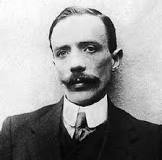Percy E. Ludgate
Born 1883, died 1922; Irish designer of a mechanical analytical engine in about 1900.

Ludgate described a general-purpose program-controlled computer in 1909, mechanical in operation, although perhaps powered by an electric motor. It was to be capable of storing 192 numbers, each of 20 decimal digits, and would perform all the basic arithmetic operations. It was to work automatically under the control of a perforated tape, or could be controlled manually from a keyboard. What is most impressive is that although Ludgate had, at least during the later stages of his work, known of Babbage's machine, much of his work was clearly entirely original, and indeed with respect to program control, a distinct advance on Babbage's ideas. In fact, all three main components of Ludgate's analytical machine-the store, the arithmetic unit, and the sequencing mechanism-show evidence of considerable ingenuity and originality.
Babbage had planned to use columns of coaxial toothed wheels to represent numbers, with the angular position of each wheel representing the value of a particular digit [The use of toothed wheels for such a purpose was already well established; it went back to at least the seventeenth century and Pascal's calculator.] His arrangements for transferring the contents of a particular storage location (that is, set of wheels) to and from the arithmetic unit involved a wondrous collection of gear wheels and racks. In contrast, Ludgate planned to represent each multidigit number by a set of sliding rods in a shuttle and to arrange such shuttles around a cylindrical shuttle box, which merely had to be rotated to bring the right number to the arithmetic unit.
Ludgate's planned arithmetic unit was even more novel. Most calculating machines of his day allowed the operator to perform multiplication using repeated addition, although some direct multiplication machines incorporated what was effectively a set of mechanical multiplication tables for single decimal digits. Ludgate, who may or may not have known of such machines, went for a novel-indeed, unique scheme for multiplication, based on what a contemporary delightfully termed "Irish Logarithms." [Boys, C.V., "A New Analytical Engine," Nature, Vol. 81, No. 2070, July 1, 1904, pp. 14-15.] Multiplication involved converting all the digits of the multiplicand and a single digit of the multiplier to index numbers; the index number corresponding to the multiplier digit was added to each of the index numbers corresponding to multiplicand digits (by additive linear motion); the results were then converted back to give a set of two-digit partial products. Ludgate's scheme for division was entirely different and equally novel. Instead of using either a conventional trial-and-error scheme of repeated subtraction and shifting, or a logarithmic scheme, he proposed a direct method, based on a series approximation. Moreover, he proposed organizing this as a built-in subroutine, using a form of read-only memory: the perforated surface of a rotating metal cylinder.
The final aspect of Ludgate's machine was the method of sequence control, or the means by which a program determined the machine's behavior. Each row of perforations across the control tape (or formula paper, as he called it) specified an instruction consisting of an operation code, two operations and addresses, and one or two result addresses. As such, the scheme was a definite advance and simplification of that proposed by Babbage and indeed has more in common with that used nearly 40 years later in the Harvard Mark I. Ludgate obviously agreed with Babbage's assessment of the crucial importance of providing a general means of conditional branching, presumably involving having a number of rows of the formula paper skipped, either forward or backward. In dramatic contrast to Babbage's Analytical Engine, Ludgate's machine was to be portable, occupying approximately 8 cubic feet. It was to be capable of multiplying two 20-decimal digit numbers in about 6 seconds. Apparently, he had made detailed drawings of the machine, but had not attempted to construct it.] [Based on Randell 1982.]
Highly respected by his colleagues, he was otherwise little known, and the only other significant achievement that was remembered was the major role he played in helping to organize the national provision of animal food supplies during World War I. He died in 1922 at the age of 39. No trace of his papers and drawings has been found. [This is a summary of the information that can be gleaned from the 1909 paper. But who was Ludgate, what was his environment, and what else had he done? My efforts to obtain answers to these questions soon had what seemed to me nearly all the librarians and archivists in Ireland working oil my behalf. One initial report I received from an archivist stated that by all normal criteria, it was clear that Ludgate had never existed. Eventually, however, the heroic efforts of the librarian of the Royal Dublin Society, who telephoned all the Ludgates in the Dublin telephone directory, traced Ludgate's niece, who enabled me to obtain his picture and to start assembling all account of his life. It turns out that he had been an accountant, who had, it is believed, done all his work on his machines in his spare time, and on his own. Brian Randell 1982]
BIBLIOGRAPHY
Biographical
Randell, Brian, "From Analytical Engine to Electronic Digital Computer: The Contributions of Ludgate, Torres, and Bush," Ann. Hist. Comp., Vol 4, No. 4, 1982, pp. 327-341.
Significant Publications
Ludgate, P.E., "On a Proposed Analytical Machine," reprinted in Randell, Brian, Origins of Digital Computers: Selected Papers, Springer-Verlag, Berlin, 1982, pp. 73-88.
UPDATES
Portrait added (MRW, 2013)
New content Copyright © 2013-2023 by the IEEE Computer Society and the Institute of Electrical and Electronics Engineers Inc.
All rights reserved. This material may not be reproduced or redistributed without the express written permission of the copyright holder.
